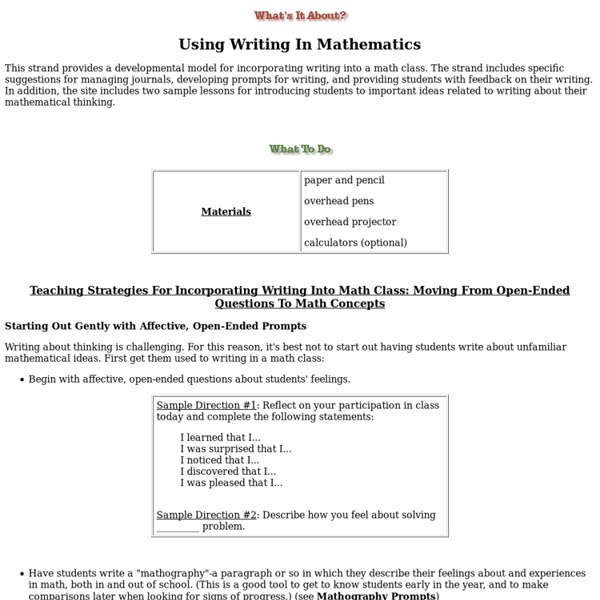MATH WORDS, AND SOME OTHER WORDS OF INTEREST
If you have suggestions or comments E-mail to: Pat Ballew ".................... Read Pat's Blogs here
How to Read Mathematics
This article is part of my new book Rediscovering Mathematics, now in paperback! How to Read Mathematics by Shai Simonson and Fernando Gouvea Mathematics is “a language that can neither be read nor understood without initiation.” 1 A reading protocol is a set of strategies that a reader must use in order to benefit fully from reading the text.
Kay Toliver: Math and Communication
Math and Communication by Kay Toliver Before I taught mathematics in grades 7 and 8 at East Harlem Tech, I taught all of the other elementary grades, starting with the first and gradually moving up through each grade, one at a time. It may have been this background which led me to want to use mathematics instruction to develop my students' communication skills, because I saw that, for all students in all grades, communication skills were among the most important abilities that I could help them to develop. Over the years I have learned that there are two sides to this coin. Not only can I use math class to develop children's abilities to speak, read, write and listen, but by stressing these communication activities I am able to be a better mathematics teacher. By encouraging students to speak up in class, to explain their reasoning, and to define the words that we are using, I learn a great deal about how well they understand the lesson.
Art with Mrs. Nguyen: Radial Paper Relief Sculptures (4th/5th)
For this lesson we began by taking about what symmetry is and the difference between linear symmetry (1 line of symmetry) and radial symmetry (more than 1 line of symmetry). Then we talked about what a sculpture is (a piece of artwork you can see from all sides - it is 3-dimensional) and what a relief "sculpture" is (a piece of artwork that has depth on the surface but is not meant to be seen from all sides). Once students understood the principles behind radial symmetry and sculpture we began creating our very own radial paper relief sculptures! Students started by folding a piece of 12"x12" black construction paper diagonally both ways and vertical and horizontally (to create an 'X' crease and a '+' crease). Making these creases makes creating a radial design SO much easier because it gives you guidelines to work with.
Dimensions Home
A film for a wide audience! Nine chapters, two hours of maths, that take you gradually up to the fourth dimension. Mathematical vertigo guaranteed! Background information on every chapter: see "Details".
Writing in Mathematics
Featured Topic: Writing in Math Class Teachers incorporate writing in math class to help students reflect on their learning, deepen their understanding of important concepts by explaining and providing examples of those concepts, and make important connections to real-life applications of the math they are learning. Teachers use the writing assignments to assess student understanding of important concepts, student proficiency in explaining and using those concepts and each student's attitude toward learning mathematics. Writing in mathematics is a win-win for both teacher and student. Although it may be difficult to introduce this practice, it is well worth the effort. Look for simple ways to incorporate short writings throughout daily lessons and longer writings over the course of weeks or math units.
Interactive angles teaching tool acute,obtuse,measure with protractor
This activity allows manipulation and investigation of various types of angles. It can be used at a variety of different grade levels. At its most basic for teaching about types of angles, acute, obtuse or reflex. For more advanced use to create angle problems in which the missing letter angle values have to be found. You can click and drag the handles to change the angles and the values will updated.
Learning Math Through Telling Stories
Tuesday, July 3, 2012 From the University of Western Ontario: “Education professor George Gadanidis is attempting to revolutionize the way math is taught in elementary classrooms by applying principles from the world of art. ‘A typical solution to helping kids learn math is making math easy to learn,’ Gadanidis said. ‘But you go watch a movie, if it is easy to learn, you will make predictions for the ending and always be right, [and that's boring]. Movies work to teach you something when you make guesses but you are surprised.
The 14 Best Data Visualization Tools
Nishith Sharma is the co-founder of frrole, a social intelligence startup. Raw data is boring and it’s difficult to make sense of it in its natural form. Add visualization to it and you get something that everybody can easily digest. Not only you can make sense of it faster, but you can also observe interesting patterns that wouldn’t be apparent from looking only at stats. All Killer, No Filler This one’s different, trust us.



